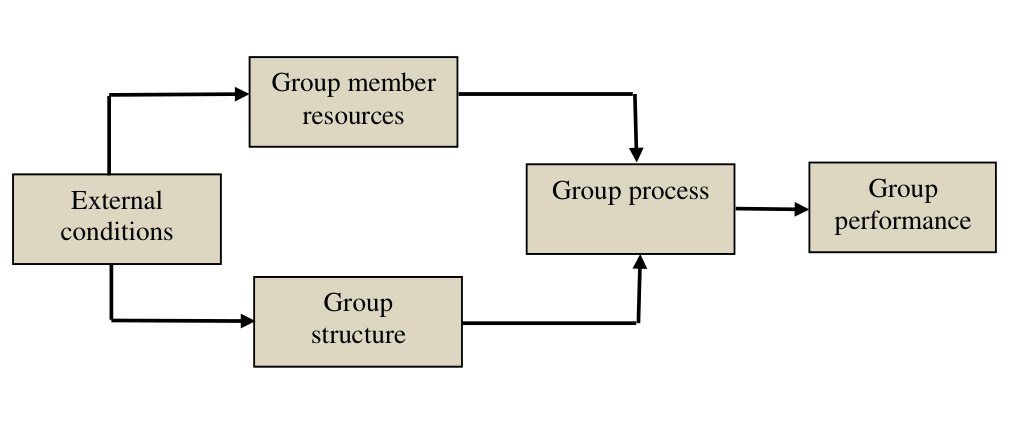Table of Contents
What is Group Behavior?
In the context of groups, it happens that some groups perform well and generate synergy whereas some groups do not perform well and result in social loafing. This happens because there are several factors, both within groups and outside these, which affect group performance. Such factors have been presented below:

External Conditions
A group is not an independent identity but it is created by an organization to perform certain specified work. Thus, a group has to work within the framework provided by the organization.
The workgroup is a subsystem embedded in a larger system. It does not exist in isolation but is a part of the larger organization. External conditions are imposed on a workgroup:
- An organization’s overall strategy, generally given by top management, outlines the organization’s goals and the means for attaining these goals.
- The strategy will influence the power of various work groups which will determine the resources that the organization’s top management is willing to allocate to it for performing its tasks.
- Organizations have authority structures that define who reports to whom, who makes decisions, and what decisions individuals or groups are empowered to make.
- Organizations create rules, procedures, policies, job descriptions, and other forms of formal regulations to standardize employee behavior.
- The performance evaluation and reward system. Group members’ behavior will be influenced by how the organization evaluates performance and what behaviors are rewarded.
- Every organization has an unwritten culture that defines standards of acceptable and unacceptable behavior for employees. Members of work groups have to accept the standards implied in the organization’s dominant culture if they are to remain in good standing.
- The physical work setting creates both barriers and opportunities for work-group interaction.
Group Member Resources
Group performance depends, to a considerable extent, on the resources that its individual member brings into the group. This comprises of:
Abilities of Members
The performance of a group may be influenced by the task-relevant intellectual abilities of each of its members. Research evidence indicates that individuals who hold crucial abilities for attaining the group’s task tend to be more involved in group activity, generally contribute more, are more likely to emerge as group leaders, and are more satisfied if their talents are effectively utilized by the group.
Further, intellectual ability and task-relevant ability have both been found to be related to overall group performance. However, the correlation between the abilities of members and group performance is subject to the impact of such variables as the size of the group, the nature of the task, the action of its leader, and the level of intra-group conflict or cooperation.
Personality Characteristics
The personality traits of group members can shape group attitudes and behavior. The attributes that have a positive connotation tend to be positively related to group productivity, morale, and cohesiveness.
These include traits such as authoritarianism, dominance, and manipulation tend to have an effect on group performance in the long run.
Group Structure
Groups may be classified into different types. The basis of differentiation may be the purpose, extent of structuring, process of formation, and size of the group membership. However, the most important types of groups in organizations are formal and informal groups:
- Primary and Secondary Groups
- Membership and Reference Groups
- Command and Task Groups
- In-Groups and Out-Groups
- Formal and Informal Groups
Primary and Secondary Groups
A primary group is characterized by intimate, face-to-face association and cooperation. The membership of such a group is small and is based on intimate relationships.
For example: family, and peer group. Secondary groups are characterized by large size and individuals’ identification with values and beliefs prevailing in them rather than actual interaction. For example Occupational associations and ethnic groups.
Membership and Reference Groups
Membership groups are ones to which the individual actually belongs. For example Clubs, cooperative societies, worker’s unions, etc. Reference groups are the ones with which an individual identifies or to which he would like to belong.
Command and Task Groups
Command groups are composed of subordinates who report directly to a common superior. For example A college principal and teachers. A task group is comprised of employees who work together to complete a particular task or project.
In-Groups and Out-Groups
In-groups represent a clustering of individuals holding prevailing values in a society or at least having a dominant place in social functioning.
For example Members of a team. Out-groups are the masses or conglomerates viewed as subordinate or marginal in the culture. It is usually referred to as the minority group even though in certain instances. For example Street performers for office workers.
Formal and Informal Groups
A formal group is one that is deliberately created to perform a specific task. Members are usually appointed by the organization, but it may not always be the case.
A number of people assigned to a specific task from a formal group. One example of such a group is a committee and other examples are work units, such as a small department, or a research and development laboratory.
A distinctive feature of formal groups is that a hierarchy of authority exists, with specified members of rules. Rules, regulations, incentives, and sanctions guide the behavior of small groups and bring out the contributions of formal groups.
Informal groups, on the other hand, are created in the organization because of the operation of social and psychological forces operating at the workplace. Members create such groups for their own satisfaction and their work is not regulated by the general framework of organizational rules and regulations.
